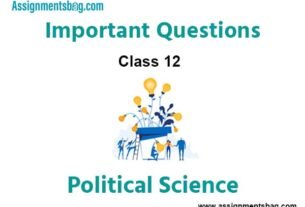Please refer to Haloalkanes and Haloarenes Class 12 Chemistry Important Questions with solutions provided below. These questions and answers have been provided for Class 12 Chemistry based on the latest syllabus and examination guidelines issued by CBSE, NCERT, and KVS. Students should learn these problem solutions as it will help them to gain more marks in examinations. We have provided Important Questions for Class 12 Chemistry for all chapters in your book. These Board exam questions have been designed by expert teachers of Standard 12.
Class 12 Chemistry Important Questions Haloalkanes and Haloarenes
Very Short Answer Questions
Question. Draw the structure of 2-bromopentane,
Answer.

Question. Write the IUPAC name of

Answer. 4-Chloropent-1-ene
Question. Write the IUPAC name of

Answer. 4-Bromo-4-methylpent-2-ene
Question. Write the IUPAC name of
(CH3)2CHCH(Cl)CH3.
Answer. 2-Chloro-3-methyl butane
Question. Write the IUPAC name of the following compound :

Answer. 3-Chloro-2,2-dimethyl butane
Question. Write the IUPAC name of the following compound :

Answer. 2-Bromo-4-chloropentan
Question. Write IUPAC name of the following :

Answer.

Question. Give the IUPAC name of the following compound :

Answer.

Question. Write the IUPAC name of the following compound :
(CH3)3CCH2Br
Answer.

Question. Give IUPAC name of the following organic compound :

Answer.

Question. Write the structure of the compound :
4-tert-butyl-3-iodoheptane
Answer.

Question. Write the IUPAC name of the following compound :

Answer.

Question. Write the major products in the following :

Answer.

Question. Write the structure of the major product in the following reaction :

Answer.

Question. A hydrocarbon C5H12 gives only one monochlorination product. Identify the hydrocarbon.
Answer.

Question. Draw the structure of major monohalo product in the following reaction :

Answer.

Question. Why does p-dichlorobenzene have a higher m.p. than its o- and m-isomers?
Answer. p-Dichlorobenzene has higher melting point than those of o-and m-isomers because it is more symmetrical and packing is better in solid form. Hence, it has stronger intermolecular force of attraction than o-and m-isomers.

Question. Answer the following :
Haloalkanes easily dissolve in organic solvents, why?
Answer. Haloalkanes dissolve in organic solvents because the intermolecular attractions between haloalkanes and organic solvent molecules have the same strength as in the separate haloalkanes and solvent molecules.
Question. Out of ethyl bromide and ethyl chloride which has higher boiling point and why?
Answer. The boiling point of ethyl bromide is higher due to the greater magnitude of the van der Waals forces which depend upon molecular size and mass.
Question. Account for the following :
Grignard’s reagents should be prepared under anhydrous conditions.
Answer. Grignard reagents react with water to form alkanes.

So, they must be prepared under anhydrous conditions.
Question. Predict the order of reactivity of four isomeric bromobutanes in SN1 reaction.
Answer.

Question. Predict the order of reactivity of the following compounds in SN1 reaction.
C6H5CH2Br, C6H5C(CH3)(C6H5)Br,
C6H5CH(C6H5)Br, C6H5CH(CH3)Br
Answer. C6H5C(CH3)(C6H5)Br > C6H5CH(C6H5)Br >
C6H5CH(CH3)Br > C6H5CH2Br
Question. Give a chemical test of distinguish between C2H5Br and C6H5Br.
Answer. C2H5Br reacts with AgNO3 to give yellow
precipitate of AgBr while C6H5Br will not.
Question. Which will react faster in SN2 displacement, 1-bromopentane or 2-bromopentane and why?
Answer. 1-Bromopentane is a primary alkyl halide, hence reacts faster in SN2 displacement than secondary halide 2-bromopentane.
Question. Which will react faster in SN1 displacement areaction :
1-Bromobutane or 2-bromobutane and why?
Answer. 2-Bromobutane will react faster in SNl displacement reaction because it will form more stable secondary carbocation intermediate.
Question. Why is the following occur :
Chloroform is stored in closed dark coloured bottles completely filled so that air is kept out.
Answer. Chloroform when exposed to air and sunlight changes to phosgene which is a poisonous gas.

It is kept in dark coloured bottles to prevent the oxidation.
Question. Explain why in the pair, (CH3)3CCl and CH3Cl will react faster in SN2 reaction with OH– ?
Answer. CH3Cl will react faster in SN2 reaction with OH–.
Question. State one use each of DDT and iodoform.
Answer. (i) DDT is used as an insecticide and iodoform is used as a mild antiseptic
Question. Write the balanced equation for the following:
(i) When chloroform is oxidised by air.
(ii) Chloroform reacts with chlorine.
Answer.

Short Answer Questions
Question. Draw the structure of major monohalo product in each of the following reactions :

Answer.
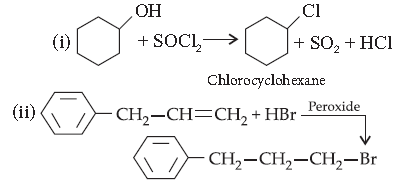
Question. Write the major product(s) in the following :
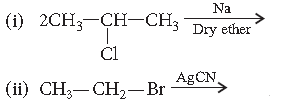
Answer.

Question. Give reasons:
(i) Racemic mixture is optically inactive.
(ii) The presence of nitro group (—NO2) at o/p positions increases the reactivity of haloarenes towards nucleophilic substitution reactions.
Answer. (i) Racemic mixture contains equal amount of d and l forms, hence rotation due to one enantiomer is cancelled by another.
(ii) The presence of nitro group at o-and p-positions withdraws electrons from the benzene ring and thus, facilitates the attack of the nucleophile on haloarenes. The carbanion thus formed is further stabilised by resonance.
Question. Write the structure of the major product in each of the following reactions :

Answer.
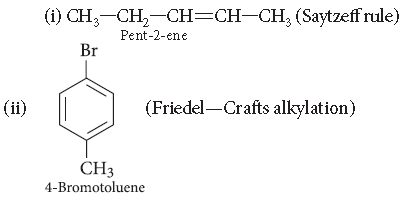
Question. (i) Why is butan-1-ol optically inactive but butan-2-ol is optically active?
(ii) Although chlorine is an electron withdrawing group, yet it is ortho-, para-directing in electrophilic aromatic substitution reactions. Why?
Answer. (i) Butan-1-ol is achrial, i.e., does not have chiral ‘C’ atom which is attached to four different groups, therefore, it is optically inactive.

Butan-2-ol is chiral, i.e., has chiral ‘C’ atom, attached to four different groups.
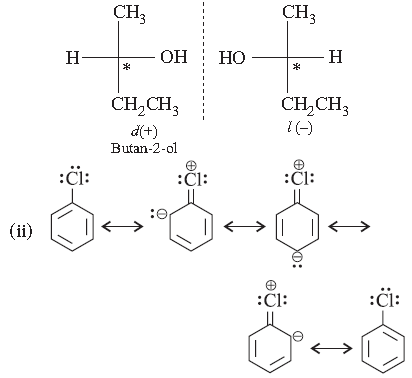
Although Cl is electron withdrawing (I effect) but still o-and p-directing as due to +R effect, electrons density is maximum at o-and p-positions.
Question. What are ambident nucleophiles? Explain with an example.
Answer. A nucleophile which can attack from more than one centres, is known as ambident nucleophile.

Question. Chlorobenzene is extremely less reactive towards a nucleophilic substitution reaction.
Give two reasons for the same.
Answer. Haloarenes are much less reactive than haloalkanes towards nucleophilic substitution reactions due to the following reasons.
(i) Resonance effect : In haloarenes the electron pairs on halogen atom are in conjugation with p-electrons of the ring and the following resonating structures are possible.

C — Cl bond acquires a partial double bond character due to resonance. As a result, the bond cleavage in haloarene is difficult than haloalkane and therefore, are less reactive towards nucleophilic substitution reaction.
(ii) Difference in hybridisation of carbon atom in C X bond.
Question. Haloalkanes undergo nucleophilic substitution whereas haloarenes undergo electrophilic substitution. Explain.
Answer. In haloarenes –ve charge gets localised on arenes using resonance, therefore they undergo electrophilic substitution.
Haloalkanes have electrophilic carbon centre due to

Question. Answer the following :
(i) What is known as a racemic mixture? Give an example.
(ii) Of the two bromoderivatives, C6H5CH(CH3)Br and C6H5CH(C6H5)Br, which one is more reactive in SN1 substitution reaction and why?
Answer. enantiomers is called racemic mixture. A racemic mixture is optically inactive due to external compensation.
Example :

(ii) Of the two bromo derivatives, C6H5CH(CH3)Br and C6H5CH(C6H5)Br, the C6H5CH(C6H5)Br is more reactive than C6H5(CH3)Br for SN1 reaction because its carbocation is resonance stabilised by two phenyl groups
Question. Which one in the following pairs of substances undergoes SN2 substitution reaction faster and why?

Answer.
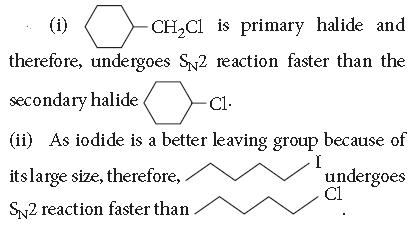
Question. Which one in the following pairs undergoes SN1 substitution reaction faster and why?

Answer.

Tertiary halide reacts faster than secondary halide because of the greater stability of tert. carbocation.

Question. What is Saytzeff rule? Illustrate with suitable example.
Answer. Saytzeff rule : In elimination reaction alkene having the lesser number of hydrogen on the double bonded carbon atom is formed. This generalisation is known as Saytzeff rule for example.
CH3 CH2 CHBr CH3

Question. Give one example of each of the following reactions :
(i) Wurtz reaction
(ii) Wurtz-Fittig reaction.
Answer. (i) Wurtz reaction : It converts alkyl halide into higher alkane in presence of sodium metal and dry ether.

(ii) Wurtz-Fittig reaction : It converts aryl halide into alkyl arenes in presence of sodium metal and ether.

Long Answer Questions
Question. Answer the following questions:
(i) What is meant by chirality of a compound?
Give an example.
(ii) Which one of the following compounds is more easily hydrolysed by KOH and why?
CH3CHClCH2CH3 or CH3CH2CH2Cl
(iii) Which one undergoes SN2 substitution reaction faster and why?

Answer. (i) Chiral object : An object which has no plane of symmetry (cannot be divided into two identical halves) is called chiral (Greek; Chiral-Hand) or dissymmetric or asymmetric. A Chiral object is not superimposable on its mirror image.
e.g., left and right hand of a person are mirror images of each other and are not superimposable.

because it is secondary halide.
(iii) As iodide is a better leaving group because of

Question. Rearrange the compounds of each of the following sets in order of reactivity towards SN2 displacement:
(i) 2-Bromo-2-methylbutane, 1-Bromopentane, 2-Bromopentane
(ii) 1-Bromo-3-methylbutane, 2-Bromo-2- methylbutane,3-bromo-2-methylbutane
(iii) 1-Bromobutane, 1-Bromo-2, 2-dimethyl propane, 1-Bromo-2-methylbutane
Answer. (i) 1-Bromopentane > 2-Bromopentane > 2-Bromo-2-methylbutane.
(ii) 1-Bromo-3-methylbutane > 3-Bromo-2-methylbutane > 2-Bromo-2-methylbutane
(iii) 1-Bromobutane > 1-Bromo-2-methylbutane > 1-Bromo-2,2-dimethylpropane
Question. (a) Write a chemical test to distinguish between :
(i) Chlorobenzene and benzyl chloride
(ii) Chloroform and carbon tetrachloride
(b) Why is methyl chloride hydrolysed more easily than chlorobenzene?
Answer. (a) (i) Benzyl chloride gives white precipiate with AgNO3 solution while chlorobenzene does not
(ii) CHCl3 with aniline in presence of alc. KOH gives foul smelling isocyanides whereas CCl4 does not.
(b) CH3Cl is hydrolysed easily than C6H5Cl as chlorobenzene has partial double bond character between C — Cl bond which is difficult to break.



